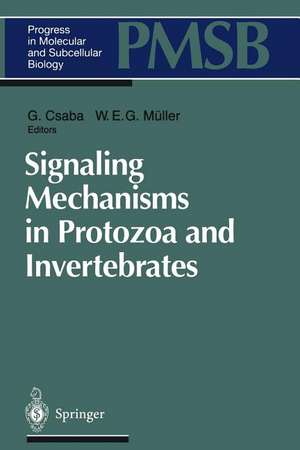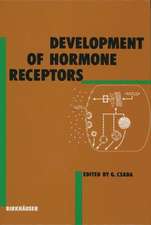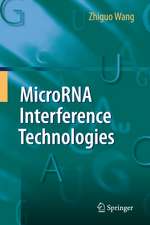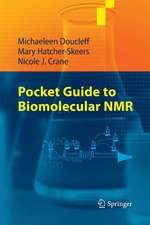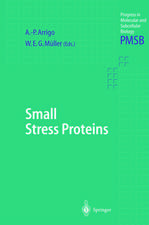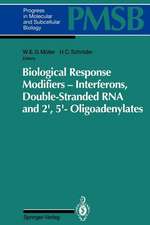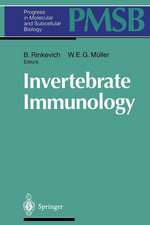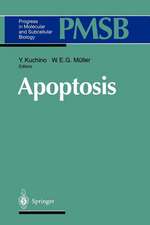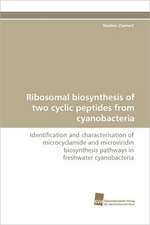Signaling Mechanisms in Protozoa and Invertebrates: Progress in Molecular and Subcellular Biology, cartea 17
Editat de G. Csaba, W.E.G. Mülleren Limba Engleză Paperback – 23 dec 2011
Din seria Progress in Molecular and Subcellular Biology
- 18%
 Preț: 1115.46 lei
Preț: 1115.46 lei - 18%
 Preț: 1403.04 lei
Preț: 1403.04 lei - 18%
 Preț: 1112.30 lei
Preț: 1112.30 lei - 18%
 Preț: 1117.03 lei
Preț: 1117.03 lei - 18%
 Preț: 1222.49 lei
Preț: 1222.49 lei - 18%
 Preț: 1382.21 lei
Preț: 1382.21 lei - 18%
 Preț: 1232.26 lei
Preț: 1232.26 lei - 18%
 Preț: 1222.80 lei
Preț: 1222.80 lei - 24%
 Preț: 1045.93 lei
Preț: 1045.93 lei - 18%
 Preț: 956.50 lei
Preț: 956.50 lei -
 Preț: 387.20 lei
Preț: 387.20 lei - 15%
 Preț: 639.73 lei
Preț: 639.73 lei - 15%
 Preț: 633.19 lei
Preț: 633.19 lei - 15%
 Preț: 634.18 lei
Preț: 634.18 lei - 15%
 Preț: 634.00 lei
Preț: 634.00 lei - 15%
 Preț: 640.24 lei
Preț: 640.24 lei - 5%
 Preț: 714.27 lei
Preț: 714.27 lei - 15%
 Preț: 634.32 lei
Preț: 634.32 lei - 15%
 Preț: 637.78 lei
Preț: 637.78 lei - 15%
 Preț: 637.28 lei
Preț: 637.28 lei - 15%
 Preț: 649.06 lei
Preț: 649.06 lei -
 Preț: 387.75 lei
Preț: 387.75 lei - 18%
 Preț: 1220.75 lei
Preț: 1220.75 lei - 18%
 Preț: 1224.99 lei
Preț: 1224.99 lei - 18%
 Preț: 946.87 lei
Preț: 946.87 lei - 15%
 Preț: 633.35 lei
Preț: 633.35 lei - 18%
 Preț: 944.36 lei
Preț: 944.36 lei -
 Preț: 387.96 lei
Preț: 387.96 lei - 15%
 Preț: 633.02 lei
Preț: 633.02 lei - 15%
 Preț: 640.88 lei
Preț: 640.88 lei - 5%
 Preț: 720.10 lei
Preț: 720.10 lei
Preț: 637.28 lei
Preț vechi: 749.73 lei
-15% Nou
Puncte Express: 956
Preț estimativ în valută:
121.98€ • 132.54$ • 102.53£
121.98€ • 132.54$ • 102.53£
Carte tipărită la comandă
Livrare economică 21 aprilie-05 mai
Preluare comenzi: 021 569.72.76
Specificații
ISBN-13: 9783642801082
ISBN-10: 3642801080
Pagini: 232
Ilustrații: XIII, 212 p.
Dimensiuni: 155 x 235 x 12 mm
Greutate: 0.33 kg
Ediția:Softcover reprint of the original 1st ed. 1996
Editura: Springer Berlin, Heidelberg
Colecția Springer
Seria Progress in Molecular and Subcellular Biology
Locul publicării:Berlin, Heidelberg, Germany
ISBN-10: 3642801080
Pagini: 232
Ilustrații: XIII, 212 p.
Dimensiuni: 155 x 235 x 12 mm
Greutate: 0.33 kg
Ediția:Softcover reprint of the original 1st ed. 1996
Editura: Springer Berlin, Heidelberg
Colecția Springer
Seria Progress in Molecular and Subcellular Biology
Locul publicării:Berlin, Heidelberg, Germany
Public țintă
ResearchCuprins
Evolutionary Significance of the Hormone Recognition Capacity in Unicellular Organisms. Development of Hormone Receptors.- 1 Introduction.- 2 Receptor Memory: Hormonal Imprinting.- 3 Problems of the Specificity of Imprinting.- 4 Time, Concentration, and Downregulation.- 5 Sugars of the Receptors.- 6 Cell Aging and Imprinting.- 7 Imprinting by Amino Acids and Oligopeptides.- 8 Receptors of the Nuclear Envelope.- 9 Possible Mechanisms of Imprinting.- 10 The Other Component: Hormones in Protozoa.- 11 Evolutionary Conclusions Based on the Unicellular Model.- References.- Studies on the Opioid Mechanism in Tetrahymena.- 1 Introduction to Opioid Mechanisms.- 2 The Opioid Mechanism in Tetrahymena.- 3 Conclusions.- References.- Adenylate and Guanylate Cyclases in Tetrahymena.- 1 Introduction.- 2 Cyclic Nucleotide Metabolism in Tetrahymena.- 3 Cyclases Involved in Cell Metabolism and Functions.- 4 Regulatory Mechanisms of Cyclases.- 5 Structure and Intracellular Distribution of Calmodulin.- 6 Conclusion.- References.- Signal Peptide-Induced Sensory Behavior in Free Ciliates: Bioassays and Cellular Mechanisms.- 1 Introduction.- 2 Peptide Signals in Ciliates.- 3 Bioassays Measuring Peptide-Induced Changes of Cell Behavior and Ciliary Activity.- 4 Cellular Mechanisms Related to Peptide Action on Individual Cell Behavior.- 5 Concluding Remarks.- References.- Ciliate Pheromones.- 1 Introduction.- 2 Background.- 3 Pheromone Notation and Origin.- 4 Pheromone Secretion and Purification.- 5 Pheromone Structure.- 6 Pheromone Genes.- 7 Pheromone Receptors.- 8 Competitive Pheromone Receptor-Binding Reactions.- 9 Pheromones as Growth Factors.- 10 Concluding Remarks.- References.- Cell-Surface GPI Expression in Protozoa. The Connection with the PI System.- 1 Introduction.- 2 The Cell-SurfaceExpression of GPI-Anchored Proteins in the Protozoa.- 3 Inositol Phospholipids in Tetrahymena pyriformis. The Possible Link Between the PI System and Synthesis of GPI.- References.- Cell Adhesion Proteins in the Nonvertebrate Eukaryotes.- 1 Introduction.- 1.1 History and Philosophy.- 1.2 Evolution.- 2 Approaches and Findings.- 3 Protista.- 4 Higher Eukaryotes.- 5 An Alveolate: Plasmodium.- 6 Plants.- 7 Fungi.- 8 Metazoa.- 9 Conclusions.- 10 Characteristics of Cell Adhesion Proteins.- 11 Extracellular Matrix Interactions.- 12 Role of Lectins and Carbohydrates.- 13 Signal Transduction and Cytoplasmic Domains.- References.- Animal Lectins as Cell Surface Receptors: Current Status for Invertebrate Species.- 1 Introduction.- 2 Animal Lectins as Cell Membrane Receptors.- 3 Lectin Families in Invertebrate and Protochordate Species. Their Association with the Hemocyte Plasma Membrane.- 4 Summary and Prospects.- References.- Characterization of the Receptor Protein-Tyrosine Kinase Gene from the Marine Sponge Geodia cydonium.- 1 Introduction.- 2 Protein Kinases.- 3 Receptor Protein-Tyrosine Kinases.- 4 Receptor Protein-Tyrosine Kinase from the Sponge Geodia cydonium.- 5 Proposed Function of the Sponge Receptor Protein-Tyrosine Kinase.- 6 Implication for Molecular Evolution of Metazoa.- 7 Summary and Perspectives.- References.
